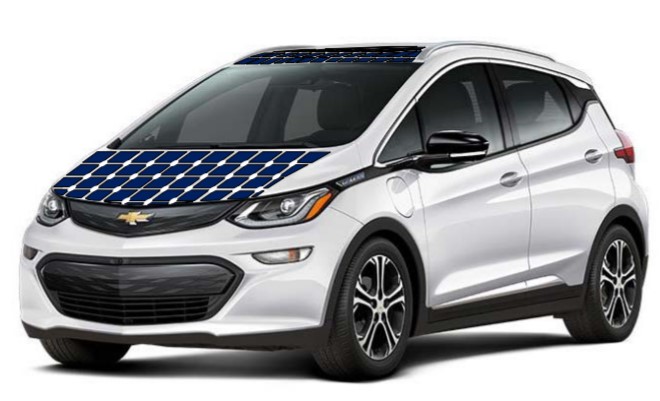Electric Vehicles (EVs) have become one of the most promising technologies in the fight to reduce greenhouse gas emissions and lower our carbon footprint, yet their environmental impact varies depending on the source of power they run on. Today, many electrical grids, which owners rely on to charge their vehicles, are still powered by fossil fuels rather than renewable energy sources such as solar and wind.
To see a substantial ecological benefit from EVs, more efforts need to be taken to decarbonize the grid. That’s why researchers from Canada have started utilizing solar power as a viable solution to help mitigate environmental concerns caused by EVs.
The team’s low-cost and flexible concept integrates thin-film photovoltaic (PV) cells into the upwards-facing body panels of an electric vehicle, such as the hood, roof and trunk. The concept expands the scope of solar-powered electric vehicles by studying the effects of panel tilt, vehicle direction and partial shading on solar generation to realize the full benefits of large-scale solar EVs (SEVs).
“The purpose of the large-scale solar EV (SEV) system is to harness enough solar power on-board that over the course of a day, a meaningful reduction in grid charging can be achieved,” said Jennifer Bauman, an assistant professor of electrical engineering with McMaster University in Canada. “This translates into benefits for the grid, drivers and the environment. Since solar power is generally intermittent, the use of the EV traction battery to store this energy is a convenient solution.”
As outlined in Figure 1, a Chevrolet Bolt EV was used as the model for the team’s onboard solar solution.

Figure 1: The Chevrolet Bolt model used as the SEV.
Battery recharging – the Achilles heel of EVs – is a more complicated process than filling up an empty tank with fuel. Today, most power grids are not designed to handle EV charging. In fact, there is an average energy or transmission loss of 12% from large generating stations to local residential loads. This means EVs are consuming 12% more energy than they’re using to drive on the road. Some energy is converted to heat or used to keep the battery temperature at bay during charging periods.
Additionally, solar power is intermittent, meaning that the energy differs depending on the region or location on Earth. The sun is not shining at all hours of the day, making it difficult to use this resource consistently without proper storage methods.
The team’s full-scale SEV concept addresses both of these challenges by leveraging the EV’s built-in battery to store the energy. As for duration and range, the wireless charging solution can leverage free and clean solar energy to charge the battery at all times, including during travel periods or when parked. Figure 2 outlines the team’s proposed onboard solar assembly.

Figure 2: A block diagram of the team’s model with the proposed on-board solar assembly
“As a society, we must consider where our EV charging energy comes from, rather than assuming there is always an abundant and clean supply of charging electricity from the grid,” said Jennifer. “By putting some of the onus on the vehicle to generate a portion of its energy, we move towards a truly sustainable transportation system. We also save transmission and distribution losses from regular grid charging, and give solar energy a convenient built-in storage battery, rather than investing in separate stationary batteries to deal with solar energy’s intermittent nature.”
To test the system’s effectiveness on the grid, driver and environment, the team studied the driving patterns of 150 drivers in Los Angeles and Detroit over the course of a full year, using the SEV model. As outlined in Figure 3, the proposed full-scale SEV can reduce charging needs by about 20% depending on location, cloud conditions and driving habits. This is analogous to an increase in efficiency of 20%, and according to the team, there is not a single other EV concept that has the potential to reduce large grid energy use like this.

Figure 3: Simulated annual average grid energy consumption in grid kWh/100 km.
A low-cost SEV has the potential to empower a massive transition to solar power from traditional fuel vehicles. As a next step, the team is currently working with a major automotive manufacturer to incorporate their concept. They’ll be focused on developing a process that would allow the solar cells to be integrated into the automotive steel so it can be mass manufactured.
For more information on solar energy and electric vehicles, visit the IEEE Xplore digital library.





